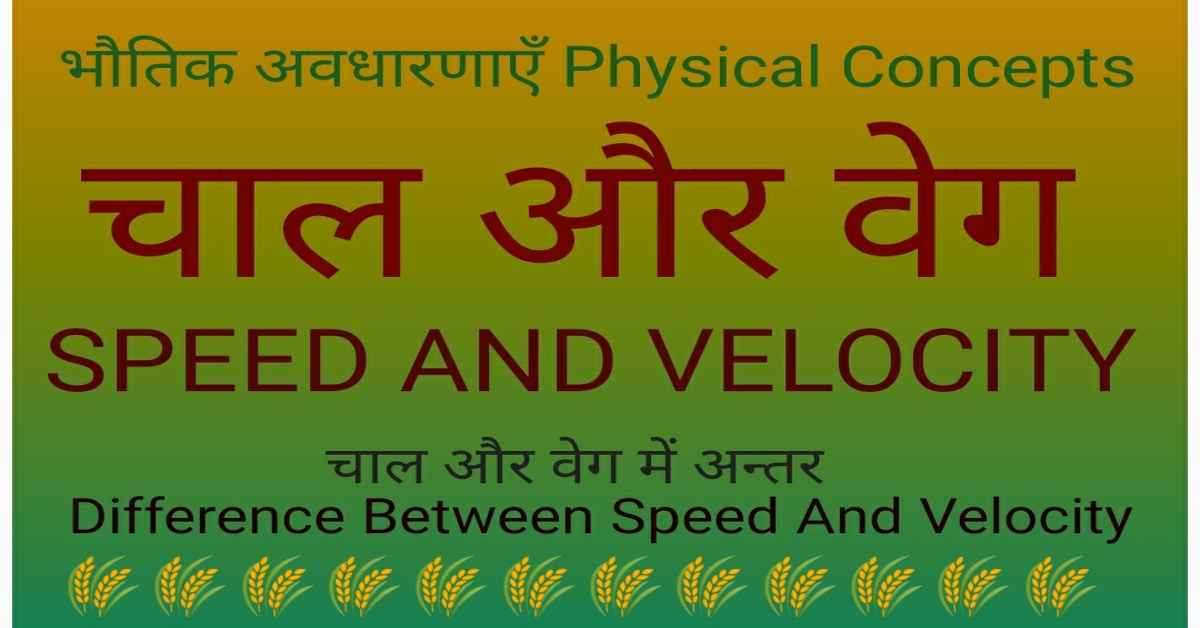
चाल और वेग में क्या अन्तर है? | चाल और वेग की परिभाषा || Speed And Velocity
चाल (Speed)
किसी गतिशील वस्तु द्वारा एक सेकण्ड में तय की गई दूरी को 'चाल' कहते हैं। अर्थात् गतिशील वस्तु द्वारा एक एकांक समय में चली गयी दूरी को चाल कहते हैं। चाल एक अदिश राशि है। इसे व्यक्त करने के लिए केवल परिमाण की आवश्यकता होती है, दिशा की नहीं। चाल हमेशा धनात्मक होती है। यह कभी ऋणात्मक नहीं होती। चाल का सूत्र–
चाल = दूरी/समय
इस सूत्र के आधार पर चाल का मात्रक प्राप्त किया जाता है।
चाल का मात्रक = दूरी का मात्रक/समय का मात्रक
चाल का मात्रक = मीटर/सेकण्ड
अतः चाल का मात्रक मीटर/सेकण्ड (m/s) होता है।
The distance covered by a moving object in one second is called 'speed'. That is, the distance traveled by a moving object in a unit time is called speed. Speed is a scalar quantity. It only needs magnitude, not direction, to express it. The move is always positive. It is never negative. Speed Formula–
speed = distance/time
On the basis of this formula, the unit of speed is obtained.
Unit of speed = Unit of distance / Unit of time
Unit of speed = m/s
Hence, the unit of speed is m/s.
भौतिक विज्ञान के इन 👇 प्रकरणों को भी पढ़ें। (Also read these 👇 episodes of Physics.)
भौतिक अवधारणाएँ– दूरी और विस्थापन | Physical Concepts– Distance And Displacement
वेग (Velocity)
किसी गतिशील वस्तु द्वारा एक निश्चित दिशा में एक सेकण्ड में तय की गयी दूरी को 'वेग' कहते हैं। अर्थात् गतिशील वस्तु द्वारा एक निश्चित दिशा में एकांक समय में तय की गयी दूरी को वेग कहा जाता है। वेग एक सदिश राशि है। इसे व्यक्त करने के लिए दिशा और परिमाण दोनों की आवश्यकता होती है। वेग धनात्मक, ऋणात्मक या शून्य हो सकता है। इसके द्वारा वस्तु की गति की दिशा का ज्ञान होता है। वेग का सूत्र–
वेग = विस्थापन/समय
इस सूत्र के अनुसार, विस्थापन परिवर्तन की दर को वेग कहा जाता है। वेग के सूत्र के द्वारा ही इसका मात्रक प्राप्त किया जाता है।
वेग का मात्रक = विस्थापन का मात्रक/समय का मात्रक
वेग का मात्रक = मीटर/सेकण्ड
अतः वेग का मात्रक मीटर/सेकण्ड (m/s) होता है।
The distance covered by a moving object in a certain direction in one second is called 'velocity'. That is, the distance covered by a moving object in a fixed direction in unit time is called velocity. Velocity is a vector quantity. It needs both direction and magnitude to express it. Velocity can be positive, negative or zero. By this the direction of motion of the object is known. Formula of Velocity–
Velocity = Displacement/Time
According to this formula, the rate of change of displacement is called velocity. Its unit is obtained by the formula of velocity.
Unit of Velocity = Unit of Displacement / Unit of Time
Unit of velocity = m/s
Hence, the unit of velocity is m/s.
भौतिक विज्ञान के इन 👇 प्रकरणों को भी पढ़ें। (Also read these 👇 episodes of Physics.)
एकविमीय, द्विविमीय एवं त्रिविमीय गतियाँ | Motion In One, Two And Three Dimensions
चाल और वेग में अन्तर (Difference Between Speed And Velocity)
चाल और वेग में अन्तर निम्नलिखित है–
1. किसी गतिशील वस्तु द्वारा एक सेकण्ड में तय की गयी दूरी को उस वस्तु की चाल कहा जाता है। गतिशील वस्तु द्वारा किसी निश्चित दिशा में एक सेकण्ड में तय की गयी दूरी को उस वस्तु का वेग कहा जाता है।
2. चाल एक अदिश राशि है। इसे अभिव्यक्त करने के लिए केवल परिमाण की आवश्यकता होती है, दिशा की नहीं। वेग एक सदिश राशि है। इसे व्यक्त करने के लिए दिशा और परिमाण दोनों की आवश्यकता होती है।
3. चाल सदैव धनात्मक होती है। वेग धनात्मक, ऋणात्मक या शून्य हो सकता है।
4. यदि वेग परिवर्ती है तो, यह आवश्यक नहीं कि चाल भी परिवर्ती होगी। चाल एकसमान भी हो सकती है। इसके विपरीत यदि चाल परिवर्ती है, तो वेग भी परिवर्ती होगा।
5. चाल के द्वारा वस्तु की गति की दिशा का ज्ञान नहीं होता, जबकि वेग वस्तु की गति की दिशा बताता है।
The following is the difference between speed and velocity–
1. The distance covered by a moving object in one second is called the speed of that object. The distance covered by a moving object in a certain direction in one second is called velocity of that object.
2. Speed is a scalar quantity. To express it, only magnitude is needed, not direction. Velocity is a vector quantity. It requires both direction and magnitude to be expressed.
3. Speed is always positive. Velocity can be positive, negative or zero.
4. If velocity is variable, then it is not necessary that speed will also be variable. The gait may also be the same. Conversely, if the speed is variable, then the velocity will also be variable.
5. The direction of motion of an object is not known by speed, whereas velocity tells the direction of motion of the object.
भौतिक विज्ञान के इन 👇 प्रकरणों को भी पढ़ें। (Also read these 👇 episodes of Physics.)
किलोमीटर को सेन्टीमीटर में कैसे बदलें | मात्रकों का रूपान्तरण || Conversions Of Units
आशा है, उपरोक्त जानकारी उपयोगी एवं महत्वपूर्ण होगी।
(I hope the above information will be useful and important. )
Thank you.
R. F. Tembhre
(Teacher)
pragyaab.com




Comments